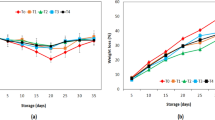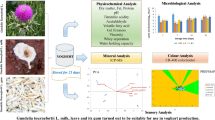Abstract
The effect of heating at various temperatures (30, 40, 50, 60, 70 and 80 °C) on dynamic viscosity, colour, 5-hydroxymethylfurfural (5-HMF) concentration and diastase activity of raw rape honey were assessed. In fresh honey, moisture, ash, free acidity, pH and electrical conductivity averaged 185.3 g kg−1, 1.2 g kg−1, 18.71 mEq kg−1, 4.2 and 0.25 mS cm−1, respectively. Heating significantly (p ≤ 0.05) increased lightness (L*), yellowness (b*), chroma (C*), hue (h°) values, but decreased redness (a*). The viscosity at 20 °C (33.6 Pa s) differed significantly (p ≤ 0.01) with those at 30, 40 and 50 °C (8.2, 2.5, and 1.6 Pa s, respectively). Diastase activity decreased concomitant with heating at higher temperatures. Honey heated at 80 °C for 15 min showed the maximum increase of 5-HMF content, with an average of 1.9 mg kg−1 (62 %), compared to unheated samples. Heating for 15 min between 50 °C and 80 °C did not significantly degrade the quality of the honey, but, slightly enhanced formation of 5-HMF and reduced the diastase activity.

Similar content being viewed by others
References
Abu-Jdayil B, Ghzawi AM, Al-Malah K, Zaitoun S (2002) Heat effect on rheology of light- and dark-colored honey. J Food Eng 51:33–38. doi:10.1016/S0260-8774(01)00034-6
Ajlouni S, Sujirapinyokul P (2010) Hydroxymethylfurfuraldehyde and amylase contents in Australian honey. Food Chem 119:1000–1005. doi:10.1016/j.foodchem.2009.07.057
Al-Malah K, McGuire J, Sproull R (1995) A macroscopic model for the single-component protein adsorption isotherm. J Colloid Interface Sci 170:261–268
Bakier S (2006) Odwracalność procesu krystalizacji miodu. Postępy Tech Przetw Spożywczego 1:30–34(in Polish)
Bakier S (2008) Investigations of the rheological properties of honey in crystallized states. Treatises and Monographs. Univ Life Sci Press, Warsaw (in Polish)
Bath PK, Singh N (2001) Effect of microwave heating on hydroxymethylfurfural formation and browning in Helianthus annuus and Eucalyptus lanceolatus honey. J Food Sci Technol 38:366–368
Beretta G, Granata P, Ferrero M, Orioli M, Maffei Facino R (2005) Standarization of antioxidant properties of honey by a combination of spectrophotometric/fluorimetric assays and chemometrics. Anal Chim Acta 533:185–191. doi:10.1016/j.aca.2004.11.010
Bogdanov S, Martin P, Lüllmann C (2009) Harmonised methods of the European Honey Commission, Apidologie extra issue: 1–59, http://www.ihc-platform.net/ihcmethods2009.pdf. Accessed 15 June 2014
Bourne M (2002) Food texture and viscosity – concept and measurement, 2nd edn. Academic Press, San Diego
Chakir A, Romane A, Marcazzan GL, Ferrazzi P (2011) Physicochemical properties of some honeys produced from different plants in Morocco. Arab J Chem. doi:10.1016/j.arabjc.2011.10.013
Chua LS, Adnan NA (2014) Biochemical and nutritional components of selected honey samples. Acta Sci Pol Technol Aliment 13(2):169–179. doi:10.17306/J.AFS.2014.2.6
CIE (2004) Colorimetry, 3rd edn. Commission International de l’Eclairage. Vienne, Austria, pp. 16–20
de la Paz Moliné M, Fernández NJ, Medici SK, Fasce D, Gende LB (2015) Effect of microwave treatment on microbial contamination of honeys and in their physicochemical and thermal properties. Pol J Food Nutr Sci 65:119–126. doi:10.1515/pjfns-2015-0031
Dobre I, Georgescu LA, Alexe P, Escuredo O, Seijo MC (2012) Rheological behaviour of different honey types from Romania. Food Res Int 49:126–132. doi:10.1016/j.foodres.2012.08.009
EU (2013) Regulation (EU) No 1308/2013 of the European Parliament and of the Council of 17 December 2013 establishing a common organisation of the markets in agricultural products and repealing Council Regulations (EEC) No 922/72, (EEC) No 234/79, (EC) No 1037/2001 and (EC) No 1234/2007 (Official Journal L 347, 20.12.2013, p. 671)
FAO (2014) Food and Agriculture Organization of the United Nations. Statistics Division, http://faostat3.fao.org/faostat-gateway/go/to/browse/Q/*/E. Accessed 15 June 2014
Feás X, Pires J, Estevinho ML, Iglesias A, De Araujo JPP (2010) Palynological and physicochemical data characterization of honeys produced in the entre-Douro and Minho region of Portugal. Int J Food Sci Technol 45:1255–1262. doi:10.1111/j.1365-2621.2010.02268.x
González-Miret ML, Terrab A, Hernanez D, Fernández-Recamales MA, Hereida FJ (2005) Multivariate correlation between colour and mineral composition of honeys and by their botanical origin. J Agric Food Chem 53:2574–2580. doi:10.1021/jf048207p
Juszczak L, Fortuna T (2006) Rheology of selected polish honeys. J Food Eng 75:43–49. doi:10.1016/j.jfoodeng.2005.03.049
Kuś PM, Congiu F, Teper D, Sroka Z, Jerković I, Tuberoso CIG (2014) Antioxidant activity, color characteristics, total phenol content and general HPLC fingerprints of six polish unifloral honey types. LWT Food Sci Technol 55:124–130. doi:10.1016/j.lwt.2013.09.016
MARD (2004) Regulation of The Polish Ministry of Agriculture and Rural Development of 18 February 2004 amending regulation on detailed requirements regarding merchantable quality of honey (The Official Journal, 40, Pos. 370, 12.03.2004)
Oroian M (2013) Measurement, prediction and correlation of density, viscosity, surface tension and ultrasonic velocity of different honey types at different temperatures. J Food Eng 119:167–172. doi:10.1016/j.jfoodeng.2013.05.029
Persano Oddo L, Piro R, et al. (2004) Main European unifloral honeys: descriptive sheets. Apidologie 35(Suppl. 1):S38–S81. doi:10.1051/apido:2004049
SAS (2013) Enterprise guide 6.1. SAS Institute Inc., Cary
Semkiw P, Skowronek W, Skubida P, Rybak-Chmielewska H, Szczęsna T (2010) Changes occurring in honey during ripening under controlled conditions based on α-amylase activity, acidity and 5-hydroxymethylfurfural content. J Apic Sci 54:55–64
Singh N, Bath PK (1998) Relationship between heating and hydroxymethylfurfural formation in different honey types. J Food Sci Technol 35:154–156
Skowronek W, Rybak-Chmielewska H, Szczęsna T, Pidek A (1994) Wpływ czynników opóźniających krystalizację miodu na jego jakość. Pszczelnicze Zesz Nauk 38:75–83(in Polish)
Szczęsna T, Rybak-Chmielewska H, Waś E, Kachaniuk K, Teper D (2011) Characteristics of polish unifloral honeys. I. rape honey (Brassica napus L. var oleifera metzger). J Apic Sci 55:111–119
Tosi EA, Ré E, Lucero H, Bulacio L (2004) Effect of honey high-temperature short-time heating on parameters related to quality, crystallisation phenomena and fungal inhibition. LWT Food Sci Technol 37:669–678. doi:10.1016/j.lwt.2004.02.005
Tosi E, Martinet R, Ortega M, Lucero H, Ré E (2008) Honey diastase activity modified by heating. Food Chem 106:883–887. doi:10.1016/j.foodchem.2007.04.025
Turhan I, Tetik N, Karhan M, Gurel F, Reyhan Tavukcuoglu H (2008) Quality of honeys influenced by thermal treatment. LWT Food Sci Technol 41:1396–1399. doi:10.1016/j.lwt.2007.09.008
Turkmen N, Sari F, Poyrazoglu ES, Velioglu YS (2006) Effects of prolonged heating on antioxidant activity and colour of honey. Food Chem 95:653–657. doi:10.1016/j.foodchem.2005.02.004
White J (1979) Spectrophotometric method for hydroxymethylfurfural in honey. J Assoc off Anal Chem 62:509–514
Wilczyńska A (2011) The effect of processing on honey quality - changes of colour parameters and HMF content under heating and storage. Zesz Nauk Uniw Ekonomicznego w Poznaniu 196:91–98(in Polish)
Wilczyńska A (2012) Evaluation of honey’s quality in aspect of factors affecting its antioxidant properties. prace nauk. Wydaw Akad Morskiej w Gdyni, Polska, p. 134(in Polish)
Yanniotis S, Skaltsi S, Karaburnioti S (2006) Effect of moisture content on the viscosity of honey at different temperatures. J Food Eng 72:372–377
Author information
Authors and Affiliations
Corresponding author
Additional information
Research highlights
• heating (15 min at 50–80 °C) does not significantly reduce the quality of the raw rape honey,
• heating of raw rape honey enhanced the process of 5-HMF formation and reduced the diastase activity,
• heating of raw rape honey significantly increased lightness, yellowness, chroma and hue, but decreased redness.
Rights and permissions
About this article
Cite this article
Kędzierska-Matysek, M., Florek, M., Wolanciuk, A. et al. Characterisation of viscosity, colour, 5-hydroxymethylfurfural content and diastase activity in raw rape honey (Brassica napus) at different temperatures. J Food Sci Technol 53, 2092–2098 (2016). https://doi.org/10.1007/s13197-016-2194-z
Revised:
Accepted:
Published:
Issue Date:
DOI: https://doi.org/10.1007/s13197-016-2194-z




